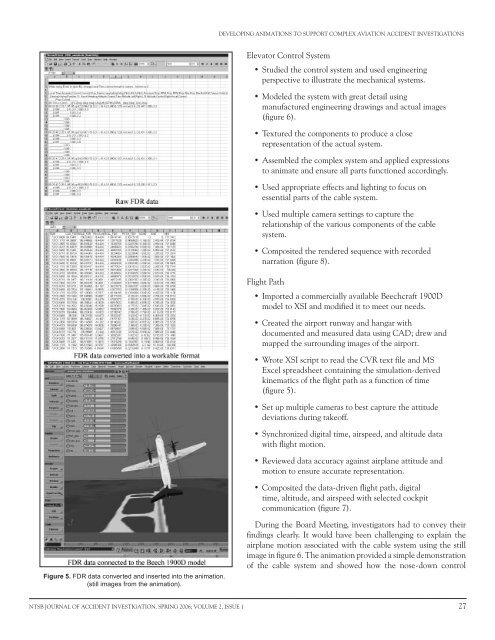Journal of Accident Investigation
Journal of Accident Investigation
Journal of Accident Investigation
Create successful ePaper yourself
Turn your PDF publications into a flip-book with our unique Google optimized e-Paper software.
Figure 5. FDR data converted and inserted into the animation.<br />
(still images from the animation).<br />
DEVELOPING ANIMATIONS TO SUPPORT COMPLEX AVIATION ACCIDENT INVESTIGATIONS<br />
Elevator Control System<br />
Studied the control system and used engineering<br />
perspective to illustrate the mechanical systems.<br />
Modeled the system with great detail using<br />
manufactured engineering drawings and actual images<br />
(figure 6).<br />
Textured the components to produce a close<br />
representation <strong>of</strong> the actual system.<br />
Assembled the complex system and applied expressions<br />
to animate and ensure all parts functioned accordingly.<br />
Used appropriate effects and lighting to focus on<br />
essential parts <strong>of</strong> the cable system.<br />
Used multiple camera settings to capture the<br />
relationship <strong>of</strong> the various components <strong>of</strong> the cable<br />
system.<br />
Composited the rendered sequence with recorded<br />
narration (figure 8).<br />
Flight Path<br />
Imported a commercially available Beechcraft 1900D<br />
model to XSI and modified it to meet our needs.<br />
Created the airport runway and hangar with<br />
documented and measured data using CAD; drew and<br />
mapped the surrounding images <strong>of</strong> the airport.<br />
Wrote XSI script to read the CVR text file and MS<br />
Excel spreadsheet containing the simulation-derived<br />
kinematics <strong>of</strong> the flight path as a function <strong>of</strong> time<br />
(figure ).<br />
Set up multiple cameras to best capture the attitude<br />
deviations during take<strong>of</strong>f.<br />
Synchronized digital time, airspeed, and altitude data<br />
with flight motion.<br />
Reviewed data accuracy against airplane attitude and<br />
motion to ensure accurate representation.<br />
Composited the data-driven flight path, digital<br />
time, altitude, and airspeed with selected cockpit<br />
communication (figure 7).<br />
During the Board Meeting, investigators had to convey their<br />
findings clearly. It would have been challenging to explain the<br />
airplane motion associated with the cable system using the still<br />
image in figure 6. The animation provided a simple demonstration<br />
<strong>of</strong> the cable system and showed how the nose-down control<br />
NTSB JOURNAL OF ACCIDENT INVESTIGATION, SPRING 2006; VOLUME 2, ISSUE 1 27<br />
•<br />
•<br />
•<br />
•<br />
•<br />
•<br />
•<br />
•<br />
•<br />
•<br />
•<br />
•<br />
•<br />
•
















